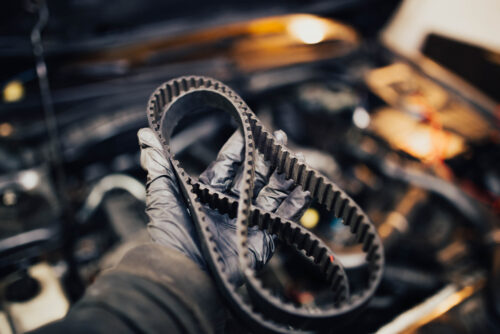How to Tell If Your Timing Belt Needs Replacing

Cars can be expensive enough to run, and the last thing you need to worry about is something going wrong. Sometimes, knowing the telltale signs of car troubles and catching them early can end up saving you a lot of time and money.
This guide will help you identify some of the main bad timing belt or timing chain symptoms Honda vehicles exhibit, the effects of this and how to change a timing belt or chain.
How to spot the symptoms of a bad timing belt on Honda vehicles
A timing belt or timing chain is there to synchronise the camshaft and crankshaft movements, keeping your car running. Here are the main symptoms of a bad or failing timing belt that might be a sign to get it checked or replaced.
- A drop in oil pressure – If you notice a dramatic drop in your oil pressure, you should stop driving and turn the vehicle off. This usually means the belt is failing and the timing of your camshaft will be affected. Failure can lead to parts of the camshaft breaking and getting into the oil pan, consequently leading to an engine failure that would require a rebuild.
- Misfiring – Misfiring is common when timing belts fail as the cylinder opens and closes too early.
- Smoke from your tailpipe – Your timing belt plays a big part in the cars air intake and exhaust. If your belt fails, you might notice more smoke coming from the tailpipe.
- Ticking noise in your engine – A timing belt starting to wear out can sometimes make a ticking noise in your engine. Acting before this gets worse can help to save you money.
- Oil leaks – Finding oil in or around your engine can result from loosening nuts and bolts that hold your timing belt in place.
- Broken valves or pistons – If your camshaft and crankshaft stop working in synchronicity, pistons and valves can contact one another, which can be catastrophic for your engine.
Can I drive with a bad timing belt?
Depending on the severity of your timing belt issues, your car might not start at all. If it does, continuing to drive with a faulty timing belt can cause more severe engine troubles that can be expensive.
What happens when a Honda timing belt breaks?
If you are driving and your timing belt snaps, it is possible that your engine can seize. Your brakes and steering could also fail, making it a dangerous thing to happen. Further damage can be caused if small pieces of metal break off and enter the internal mechanism of your engine.
How often do you have to change the timing belt on a Honda?
This will differ depending on the manufacturer, but generally speaking, this should be anywhere between 60,000 and 100,000 miles or over four years. Some say it is worth checking as often as every 40,000 miles.
How long does it take to change a timing belt?
Changing a timing belt is not for beginners and can be a long, intricate job. It can take on average between 4 to 8 hours to replace a timing belt, depending on the vehicle.
Can you repair a bad timing belt on a Honda?
Changing a timing belt can be expensive, but so can the damage it can cause if it breaks. It is sometimes possible to repair a timing belt, but this is dependent on what is wrong with it. Speaking with an automotive mechanic to get their advice is advised.
What are the costs of replacing the timing belt on a Honda?
The cost of a timing belt replacement will vary depending on the specific vehicle, but on average, you can expect to pay around £350. This can vary greatly depending on the product you buy and the cost of labour, with some estimates going from just £200 up to £1,200.
Where to get a new timing belt for my Honda
Finding genuine Honda parts will give you peace of mind knowing they were designed explicitly for the make and model of your vehicle. At Cox Motor Parts, you will be able to explore a range of great Honda products at competitive prices.
Browse by model and year to find the latest Honda Civic parts, Honda CR-V Parts, and Honda Jazz Parts, as well as Honda oil and fluids, paint, and more.
Is it worth replacing the timing belt in my car?
Despite the expense of replacing a timing belt, it is better to do this before it is too late. Keeping an eye out for any common symptoms like your check engine light popping on, low oil pressure, engine misfires, oil leaking, a ticking noise coming from the engine, and others mentioned previously is imperative.
If you have any concerns, getting a professional mechanic that you have a fully functioning timing belt could be the difference between a temperamental car and catastrophic engine damage.
Honda timing belt FAQs
Do all Honda vehicles have timing belts?
Your Honda vehicle will likely have either a timing belt or a timing chain. The main difference between the two is the materials they are made from. Timing belts are made from high-quality rubber, whereas timing chains are metal. Timing chains tend to last longer and have been developed to create less engine noise. Timing belts were more commonly used until the early 2000s and were cheaper to buy.
Can I change a worn out timing belt on my Honda myself?
It is possible to change a timing belt on a Honda vehicle. However, it is not advised if you do not have any experience. Even for a professional mechanic, this is a time-consuming and complex job.
How long will a Honda timing belt last?
Generally speaking, this will be between 60,000 to 100,000 miles. Some reports show vehicles have reached over 200,000 on the original timing belt, but this is not recommended because of the damage it can cause if it breaks and parts enter an internal engine component.
What causes a timing belt to break?
The timing belt tensioner is pressurised by engine oil and helps to ensure the belt remains taut. If there is no oil pressure, the belt will loosen and come away from the pulleys or break.
Camshafts also need the correct oil pressure to ensure they don’t lock up. If they do, this can cause the timing belt to break.
Engine overheating is another factor that can impact a rubber timing belt, as extremes in temperature can cause cracking.
Another cause is wear and tear. Some parts will inevitably wear down over time if a car is regularly used.
Read more of our guides:





